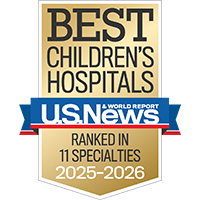Learning never stops
Our classroom and bedside classes help kids get credit and keep learning during treatment.
See our school program

A pulmonary sequestration, also known as bronchopulmonary sequestration, is a cystic piece of abnormal lung tissue that doesn't function like normal lung tissue. They usually appear next to the lung or within one part of the lung. The abnormal tissue can be microcystic, containing many small cysts, or macrocystic, containing several large cysts.
Pulmonary sequestrations vary in size and can change throughout the pregnancy. Experts do not know what causes one part of the lung to develop abnormally.
There are several types of cystic lung disease, including congenital cystic adenomatoid malformation (CCAM), pulmonary sequestration, and defects that are a mixture of the two. Pulmonary sequestrations are distinguished from CCAMs by a blood vessel that comes directly from the aorta, the main artery.
To request an appointment, call the Fetal Treatment Center: (800) 793-3887
Most babies with pulmonary sequestration have a very good outcome. The pulmonary sequestrations remain the same size or grow with the fetus, but usually do not cause severe problems, probably because there is enough room for the normal part of the lung to grow. The mass may shrink in size before birth. In all these cases, the outlook for a normal life is excellent. These fetuses should be followed closely, delivered near term, and the pulmonary sequestration should be removed surgically after birth. Often the removal is an elective procedure in early childhood.
A small number of fetuses with pulmonary sequestrations may develop large pleural effusions — excess fluid in the chest cavity — and even signs of heart failure. Unlike CCAMs, which cause trouble because of their size, pulmonary sequestrations may cause trouble because of the high blood flow through the tumor. These are the only cases that require treatment before birth.
Pulmonary sequestrations are diagnosed with a prenatal ultrasound showing a mass in the chest of the fetus. The mass may displace the heart from its normal position or push the diaphragm downward, but the key feature of a sequestration is the artery leading from the cystic mass directly to the aorta. This is what distinguishes a pulmonary sequestration from a CCAM.
Small or moderate-sized pulmonary sequestrations that don't change much during the pregnancy can be successfully managed after birth, usually with surgery to remove the abnormal lung tissue. These babies typically do not have any difficulty during pregnancy or after birth.
All pulmonary sequestrations should be surgically removed because the high blood flow through the tissue can cause heart failure. This surgery is quite safe even in the first year of life, and does not compromise lung function or development. These children will grow up normally and have normal lung function.
Fetuses who do not have hydrops when the lesion is first detected must be followed closely with ultrasounds at least every week to look for the development of hydrops. Fetal hydrops is the build-up of excess fluid, which can be seen in the fetal abdomen, lungs, skin or scalp.
If the baby doesn't develop hydrops, the medical team will continue to follow a "wait and see" approach with close follow-up. Many of these lesions begin to decrease in size before 26 weeks of pregnancy, and almost all can be safely dealt with after birth at a tertiary perinatal center. Some lesions even take care of themselves entirely.
A few fetuses develop fluid collection in the chest cavity, which may be treated by placing a catheter shunt to drain the chest fluid into the amniotic fluid.
If the fetus has a very large lesion that will make resuscitation after delivery dangerous, a specialized delivery can be planned, called the ex utero intrapartum treatment (EXIT) procedure. The UCSF Fetal Treatment Center developed the EXIT procedure to manage fetal airway emergencies, but it can be adapted to facilitate immediate support with an extracorporeal membrane oxygenation (ECMO) machine, similar to a heart-lung bypass machine, or for surgical removal of very large lesions while the baby remains attached to the placenta. This is rarely necessary for pulmonary sequestrations.
UCSF Benioff Children's Hospitals medical specialists have reviewed this information. It is for educational purposes only and is not intended to replace the advice of your child's doctor or other health care provider. We encourage you to discuss any questions or concerns you may have with your child's provider.

Ranked among the nation's best in 11 specialties

successful open fetal surgery in the world

in number of fetal surgery clinical trials
Learning never stops
